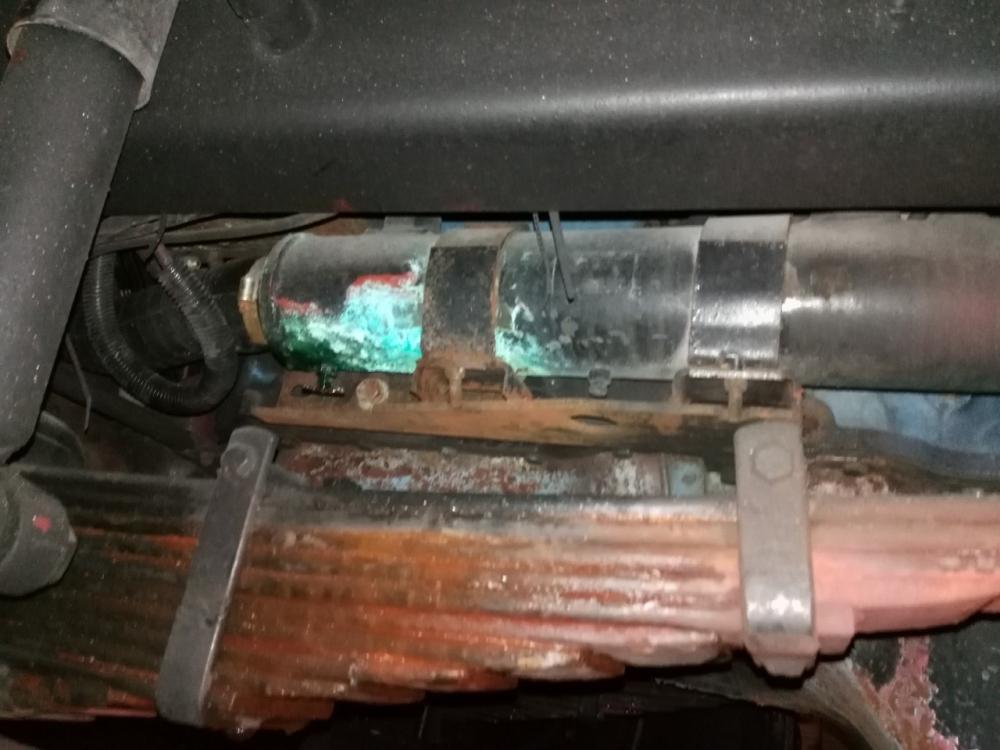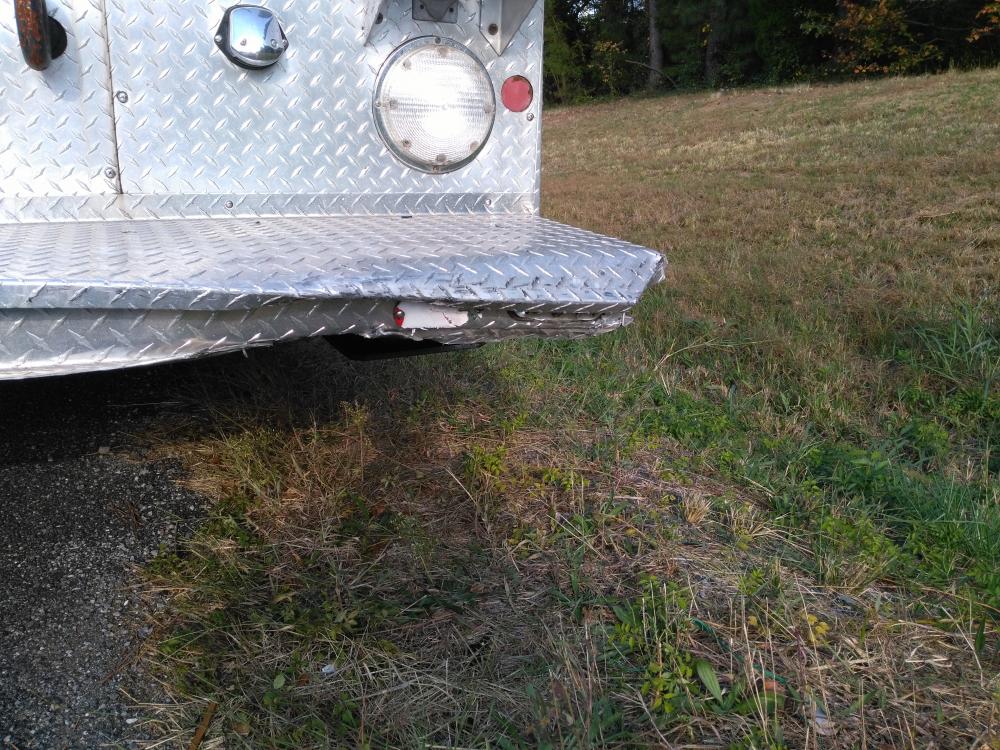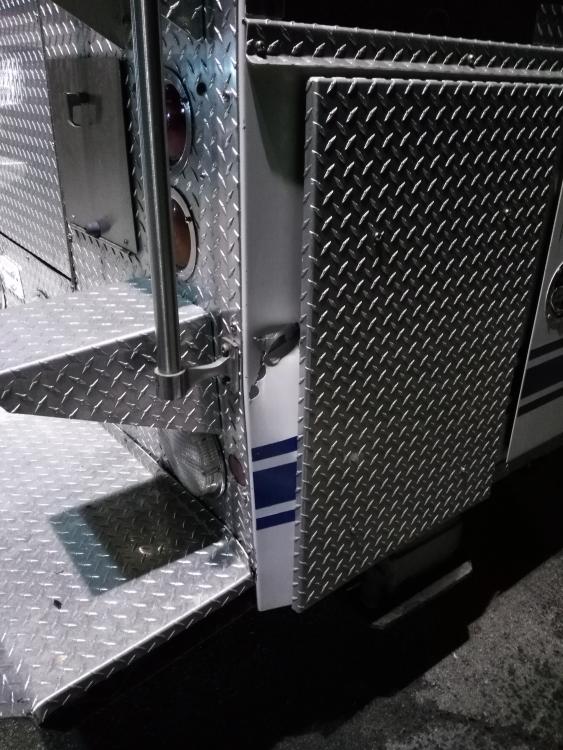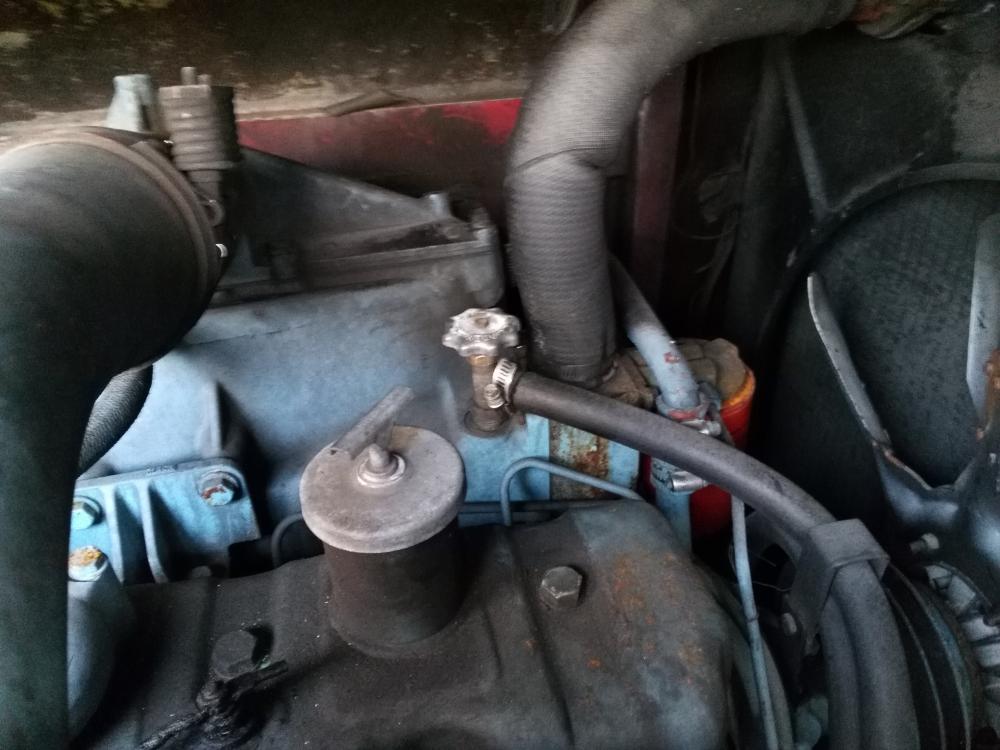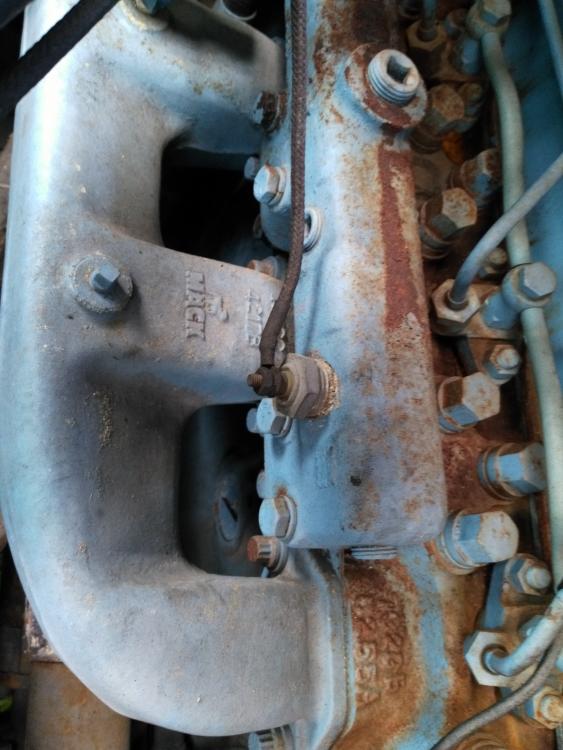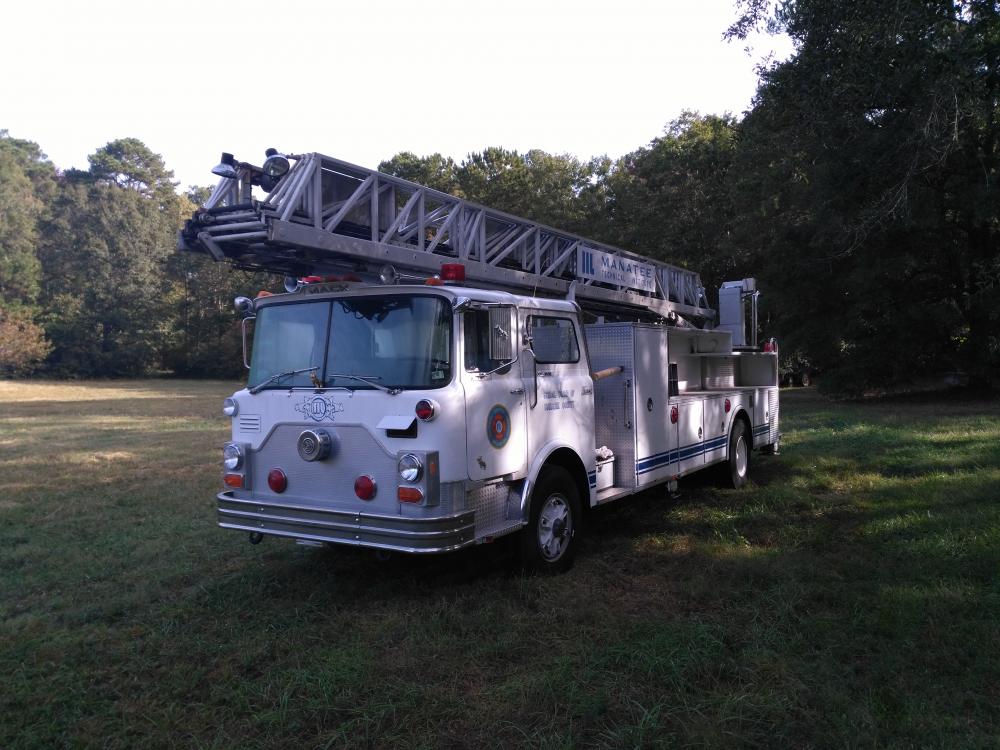
vic
Puppy Poster-
Posts
15 -
Joined
-
Last visited
Location
-
Location
Munising, MI
Profile Fields
-
Interests
Old Junkers, Old Buildings, Tall Ladders
Recent Profile Visitors
The recent visitors block is disabled and is not being shown to other users.
vic's Achievements
-
Safe Operating Water/Coolant Temp?
vic replied to vic's topic in Antique and Classic Mack Trucks General Discussion
Hi, Guys! Thanks for the positive input. And thanks for your patience with my writing so much at times. My Mom was an English teacher, and I do have a bit of a "writer's bug," but sometimes I know I OVERWRITE and people get sick of reading the big posts, so thanks for the kind words! As for the building I am working on and the reason for getting this truck, well, I have kept an eye open for bucket trucks and book trucks, etc, for some time, but it seems landscapers and contractors tend to buy them right up, AND seem to have more money than I, so I can never find anything that I can afford. Surprisingly, even in its condition, this truck sold for an amazingly low price-I think because of the age many actual fire departments can't use it or something. So, one reason I got it was because it was so affordable. Also, as you will see in the next attached picture, the building I am working on is TALL, and thus, many old utility trucks are not tall enough to really help me out. I have had to measure and eyeball and estimate different places and floors and levels, but I am guessing that the tallest peaks are at least 93' tall, and the ornaments on top of the peaks are about 4' tall as well, so... As many of you have seen, I did name the truck, MacKenzie because it contains the word Mack, and the old building is Patrick, because it was an old St. Patrick's Catholic Church. So they, for now, are a couple, Patrick and MacKenzie, or Pat and Mac. I am definitely looking forward to, as you guys said, actually having the time, and my friend's expert help, to trace what all the controls do and what does and doesn't work. I know how to work the ladder, but many other things are still kind of unknown! Thanks again, everyone. Will add info as it comes! Happy Mack'in'! -
Safe Operating Water/Coolant Temp?
vic replied to vic's topic in Antique and Classic Mack Trucks General Discussion
Okay, so I gave you guys a break for a while, and thought that you deserved an update if any of you have wondered. I'm sure many people were just sick of every little question, but, again, this was my first foray into BIG trucks, BIG engines, and in getting one in this great condition, I wanted to do my best NOT to screw it up, though I had limited funds and time to try to get some things done and to get it somewhere where I COULD get some things done! Bottom line is, WE MADE IT! Something like 1280 Miles in about 62 hours total, while mainly trying to hover around 40 MPH. The hour meter in the cab showed that of those 62 hours, about 37 or 38 were functional, running hours. There were a couple of spells of sitting still while idling while searching on-line for parts, the next rest area, the next truck stop, contacting my mother to see if our schedules would coincide for a visit on the way, same with a lady friend, checking this web site for advice, etc. But I had scheduled leaving Griffin, GA on Saturday morning and giving myself until Thursday EARLY AM to get into Munising, MI if necessary, and I left a day late on Sunday AM and got into Munising on Tuesday night, so was very happy that I was able to get there that quickly. The truck did as well as she could considering her heating/cooling issues/fan clutch issue. Since being here the temperature has dipped down into the 30's some nights, and this truck seems to have no glow plug circuit/system (does that show how new to this work I am?), and so I have started the engine up at least once every 24 hours and let her run for 20-30 minutes at a time, thinking this will build up/preserve a LITTLE bit of block heat. I am not sure if there is a block heater on it or not. There IS a built in "male" plug in the side of the engine bay wall, that would accept a standard three prong extension cord plug, and I have not had a chance to get under and truly follow the wires to see where this all goes, but it SEEMS to go toward the rear of the truck, where there is a generator mounted in the back, as well as a fuse box and a LONG extension cord on a spool to help power things on site. Also, mounted on one wall is an electrical box that is labeled as a battery charger. So I am not sure if this plug is a block heater, a plug in for a battery charger, or some other electrical device. I have, somewhere, one of those magnetic block heaters to stick on an engine in cold weather, but so far the truck is starting very well and easily on its own. However, any knowledge/info/advice on what weather/temps to watch starting would be appreciated. I did get around to testing the hydraulic controls in the rear for the outriggers/jacks/balancing system of the passenger side to see if the damage from the "rear-ending" that I took on the interstate did any harm to this system, and it all appears to be fine and functional, so was pleased to see that. I am taking it out to an old buddy that is a retired diesel mechanic to kind of go through it and do some of the things we've discussed (flush radiator, change oil, "tune-up", check belts, thermostat, etc) as well as start to go through it all with me and figure out all of the switches and controls and bells and whistles on it. Looking forward to that. The night I got back into town I stopped at my office for a minute to check some things and left the truck running. Upon walking back out a saw a small bit of water that seemed to be running out from under the truck. Because I had been checking everything SO closely, I was sure it wasn't me, and I must have parked on an old puddle. I bent down and rubbed my finger in it and smelled-coolant. Again, having not leaked any noticeable amount the whole trip, and from the fact the fluid was cool, I assumed it was old and not from my truck. I drove on home, about 6 miles, and then got a flashlight to take a better look. Well, it WAS coming from me. I am not sure what the part is called, but the lower radiator hose appears to run into it, and it looks like a larger sized "pipe" or "reservoir" or something, that may simply be a solid piece of tube to allow the coolant to proceed back into the engine block? It is bigger around than the radiator hose, and does have a spigot on the bottom (seems to be lowest point on the cooling system, so possibly this is the place best from which to empty the system for a coolant change/flush? It is metal of some sort, and shows the green patina of years of holding (and possibly lightly leaking) water. It was leaking a steady drip, though not even a trickle-maybe one drop every 5-10 seconds. And I have checked the system since-it seems to be holding fluid fine when sitting still, and thus, is likely a typical little pinhole style leak that only "produces" under pressure. However, the fact that it has any leak at all, in this position, while still holding fluid, etc, makes me VERY eager to repair it, so that is also something we are going to look at when I get it out to my mechanic's. I am attaching a pic of this part so that anyone that recognizes it can tell me more about what they may know about it and if there is anything particularly tricky I am getting into in working on it. Or even what it might be called so I can try to find a replacement? If it truly is only a reservoir/dispersal tube, I imagine one could be fabbed pretty easily, but if it is something terribly complex and intricate, would be good to know as well. So, that's the latest. Thanks again to all for all of the advice/input/help. I have loved the journey and the adventure, though I have to admit, I am actually considering selling this truck. Too many people have mentioned, and rightly so, that it is in pretty much collector shape and a collector's item with the low original miles and hours, etc. I need it to be a functional "work truck" with the ladder height to help me work on an old building I bought. I tend to be very FUNCTIONALLY oriented, and don't often worry much about appearances, and I really feel I may be a BAD owner for this truck and may waste her potential/beauty/amazing condition while using her as a tool. So I am kind of torn on that front. Going to all the trouble to get her here formed a "bond" for me (I do that with all my vehicles!), but at the same time, it also made me realize she needs to be appreciated as a historic piece, possibly, and not just USED as a ladder and let her get all paint-splattered and chipped and rusty. But, for now, I am just going to keep working on her, get her as good as possible, and rent an indoor storage area for her for the winter. Thanks again for reading, and for any and all info you have and can provide! Have a great day! Vic -
Safe Operating Water/Coolant Temp?
vic replied to vic's topic in Antique and Classic Mack Trucks General Discussion
Yes, I'm just hoping it didn't mess up the Hydraulics for those rear Outriggers. On another note, let me apologize to you guys. You guys have mentioned that fan clutch, and I kept thinking I couldn't possibly hear it, and then I remember the first time I heard it kick in in a school bus I have with a 5 9 Cummins in it. It sounded like a jet had started up underneath the hood, and now I know the sound you're talking about. So yes, you're right, this time driving I have been paying very close attention, and I've been hovering right around 200 degrees and have not heard it kick in. I stopped at Mack truck of Seymour Indiana, and was lucky enough to find one of their service guys on a bit of a break, and he came out and looked at it with me real quick. He's pretty sure it is the fan clutch, and that does make sense. So I apologize for not thinking this was the reason earlier when you guys first suggested it. They did not have one in stock, nor did it show any of their sister groups having one in stock in the area. But I'm going to get online and try to find one, and keep nursing this thing at 40 miles an hour up to Michigan if I have to. Thanks again for all the help on here guys. Greatly appreciated. Me and Mackenzie are back on the road. -
Safe Operating Water/Coolant Temp?
vic replied to vic's topic in Antique and Classic Mack Trucks General Discussion
Thanks for the input, Thomas Tractor Service! So, I've done some more thinking, as my brother-in-law, who worked for Mac most of his life, keeps wondering why the truck is running so warm. I'm pretty sure it's simply part of the design. This was meant to be driven short distances, in large cities, with buildings tall enough to need a hundred and six foot ladder, and to just sit still and run while the latter was an operation. The radiator is truly right behind my seat, and has no what I would call positive air flow. To top that off it is an engine in cased in basically an oven. It is in a metal box, although the bottom of course is open. So it holds heat in, and has no true radiator cooling. The only air pushed through the radiator is hot air from inside the engine chamber. So this, I think these trucks just were not meant to be driven any great distance, or to receive any cool air Cooling. Hence the reason I am running so warm. I am now in Southern Indiana. I've only had to stop twice to check the temp more closely. And she still running great. The bad news is, some idiot ran up on me yesterday and my rear, causing them to spin and run off the road. By the time I could get the big girl stopped and pulled off the road, I started walking back to see if they were okay, and they had apparently backed out and driven away. Possibly an uninsured driver? So now, my beautiful 1981 loan while Mack ladder truck has kind of a dick on her rear end. Luckily, these things are built sturdy, and it's not all that bad, but it's the thought that counts of course. The only possible Solace is that his little car, which looked like a little Ford Focus wagon or Volkswagen Golf size thing, is probably pretty mangled and the front end. So, anyway, I'm getting back on the road now to head north through Indiana. As for hearing the fan turn on, I'm really sorry, but I don't know that that is possible. I know a couple people have said that, but I'm not sure they've ever driven a truck with this configuration. It's not even in a cab over, it's a CF which I'm guessing Stanford cab forward maybe? So the engine is outside and behind me. So I have never heard anything, out of the engine, that I could discern, aside from a little bit of the turbo whine / whistle / squeal. Perhaps that is because the fan is not coming on, but, again the way this is set up, I can't really hear a whole lot of engine noises. Engine noise yes. Specific individual noises, no, not really well. -
Safe Operating Water/Coolant Temp?
vic replied to vic's topic in Antique and Classic Mack Trucks General Discussion
Also, I think the fan is the good old-fashioned constant kind. As soon as I start her up to finish turning. I don't think there's a clutch involved. I could be wrong, but the other day when I first started here the family spending right away. -
Safe Operating Water/Coolant Temp?
vic replied to vic's topic in Antique and Classic Mack Trucks General Discussion
Thanks again for your input, guys. The latest update. I have made it right around 200 miles, averaging about 40 miles an hour, which is what I had hoped. I was running a little warm up most of the time, around 200 to 10, and when hitting a climb I would maybe climb to 2:20. I got to Eagle Mountain in Tennessee, and climbed about two-thirds up. I've been pulled over as it was finally reading about 2:30 on the heat gauge. As long as I keep my RPMs below about 1800 It generally stays down around 200 to 10 most of the time. When I checked with my heat gun, it did say that the manifold near the sensor was at least 2:30, after I stopped. I have now been sitting for about 45 minutes and it's down to about 200, and I'm thinking I'm going to go ahead and start it up and try to cross the hill where she will get a big break. Plus it's time for me to stop at a truck stop and refuel, grab a snack, grab some water, Etc, which will give her a chance to rest. So, she still feels like she's running great, and his pulled Eagle Mountain admirably well. But I still am keeping my eye on that temperature gauge like crazy. And no, I did not get to Flasher, because I was so sure that the temperature gauge was wrong, and she was running fine. Thus, the time I plan to use the other day to flush her, was the time I was running back and forth to the parts store and looking online to find out where I might install the mechanical sensor. I do think flushing her would do some good, although I'm not sure how much. -
Safe Operating Water/Coolant Temp?
vic replied to vic's topic in Antique and Classic Mack Trucks General Discussion
So, just drove the truck down the road about 15 or 20 miles to get to the interstate. Stopped to fill back up before I jumped on the interstate. And tested my temperature gauge. According to my temperature gun my temperature gauge is pretty accurate, running between about 180 and 200 right now. I tested close to the temperature sensor, right on the temperature sensor, the manifold for the forward by the thermostat housing comma and on the hose itself above where the thermostat probably is. All readings were pretty close to what the gauge was saying at the time. So that makes my question trickier. Was I really running at 2:30 for 465 miles without causing any damage? The plan is to leave right now to drive to Michigan. But of course I am a little bit hesitant to do so. Time is of the essence, but not to the point where I want to ruin an original 1981 Engine with only 17,500 miles on it! So it's only about 6:30 in the morning, but if anybody sees this offer whatever input you could as to what might be going on, and what I should do. I know theoretically, in the best of all worlds, I should park it, get a professional to look at it, and wait and see what they say. However both time and money may not make that practical at this point in time. So if anyone sees this, as always, I appreciate your support and input. -
Safe Operating Water/Coolant Temp?
vic replied to vic's topic in Antique and Classic Mack Trucks General Discussion
Thanks for the confirmation! Those were both things I was thinking! Greatly appreciated! -
Safe Operating Water/Coolant Temp?
vic replied to vic's topic in Antique and Classic Mack Trucks General Discussion
-
Safe Operating Water/Coolant Temp?
vic replied to vic's topic in Antique and Classic Mack Trucks General Discussion
BR and JHancock. Thanks for replies. I am guessing I found the sending unit. Also going to Lowe's/Home Depot to get thermo gun before pulling out. If it is reading 230 again when I get moving, will temp gun that manifold in the area of the sending unit. The one I found is in the rear of the water manifold it seems. Up front, only port is one with heater hoses and round knob valve I mentioned. I read an article that said best place to put one is definitely as close as possible to the thermostat. However, that only port is heater hose one, so can't do it with what I've got with me. Maybe once home I can fab up a pipe to take in sending unit and still allow pass-through for heater hoses. Also read saying that temps can get extreme other places farther from thermostat, so maybe that adds to high reading? Manifold at that area conduct higher heat from the proximity/attachment to the head? If I have to use the thermometer gun, I think I will check near the sending unit, and again near the thermostat to see if I get considerable different readings. Going over some mountains between GA and MI, so want to make sure I know how hit I am really running! Thanks for all input, once again. Pic of suspected sensor/sending unit attached: -
Safe Operating Water/Coolant Temp?
vic replied to vic's topic in Antique and Classic Mack Trucks General Discussion
Thanks for the further input. Drove the old girl around town a bit today and the temp gauge never went over 200 (same gauge that has been in it, have not found a good place to put the new one in yet!), truck acted fine, again, etc. Couple questions: If I get a temp gun, where are you proposing I should aim it to get an accurate water temp to test the validity of the gauge? Where can I buy one of these? Parts store? Menards/Lowes? My mechanical does have the long sending unit/sensor. The hand-turn valve port that I spoke of using. though on top of the engine, was below the "water line" which surprised me as high up as it was, and I had not drained any coolant, so in trying to remove it was losing some fluid, so held off on that simply because I wasn't expecting it to be wet when sitting still and turned off. Guess that lets me know that aside from the previously mentioned pinhole, things are tight and leak free in there! So, again, with the long sending unit, any good, existing suggested places for it to go? When you say the electrical sending unit is beside the round knob for the heater, do you mean the round knob I mention back on the engine near the top rad hose entry? Or do you mean the round knob in the cab on the dash near the "radiator" portion of the heater? Where is the thermostat in this vehicle? I was expecting in what I would call the "usual place" in cars-where that top rad hose goes in at the front of the engine on top. But there is no "housing" that looks like it holds one. Just a square block that the hose goes into that also has the "hand turn round knob valve (hose spigot type) that I mentioned. Is it here? What is the method for "bleeding" out the air pockets? That adding a little coolant at a time while engine is running to "burp" the air out? Thanks again for any and all input. I did a lot of reading on line even yesterday while trying to figure out where to install the sending unit, and read that some of the sending units, especially for electrical ones, can be considered factory okay/approved at up to 14% accuracy, meaning that at 200 degrees my temp gauge could read 228 and the factory would still say it was within spec. Also read that when working, pulling, laboring, 200-205 is not out of line for one of these engines to run, so I am still thinking that, with still no signs of damage, I likely just have a very inaccurate gauge system. But finding the best place to go in with the new one (sensor/sending unit) is still turning out to be hard-especially on the road with limited tool availability. I pretty much HAVE to get on the road today, so will be trying/looking at/experimenting with all of these ideas this AM for final prep. Thanks again for any help, already offered or still to come! Pic to show the old Beauty we are trying to save! -
Safe Operating Water/Coolant Temp?
vic replied to vic's topic in Antique and Classic Mack Trucks General Discussion
I am sitting here with a good, old-fashioned mechanical temp gauge, trying to figure out where to put it. There is a small plugged outlet up in the "overflow reservoir" for the radiator (that is what I am calling the tank that is sitting ON TOP of my radiator, where I actually add water and coolant, etc, but it appears to be a separate "tank" atop the radiator, though it could be just the top of the radiator and this one is shaped in this way. Either way, there is a small, plugged, outlet here, going directly into the tank, but I am wondering if that is a good place for the temperature sensor or not. I am not sure if it would read even hotter here or even cooler here, due to location. There also would be an easy place to place the sensor, where the hoses that appear to lead inside of the cab for the heater to operate are located. This has a good old fashioned "hand turn" round knob to turn the water flow at this point on and off, as the truck was in FL and I am guessing they never needed the heater working. Thus, I could remove this valve and install the sensor there, I would think, and this might be a good read. I doubt I need the heater either for the purposes of this drive, though I certainly might if I use the truck at all during the MI winter, but for now just want to make sure I have an accurate temp read for the drive North. It is up near the front of the engine, on the top of the head, right behind where the top radiator hose comes into the head. That sound like a good, accurate spot? -
Safe Operating Water/Coolant Temp?
vic replied to vic's topic in Antique and Classic Mack Trucks General Discussion
Thanks for the input, Glitch. As I said, there was NOT any sign of it overheating-no hissing, spitting, or puking coolant everywhere. And the little drip I mentioned was not a pinhole only under pressure kind of thing. I may not have made that clear... I could watch SMALL amounts drip out when it was cooling (like an occasional "drop," literally) or cool. If the overflow reservoir was FULL to the top and sitting cool, I would expect a steady drip from it as it is, and so my personal thoughts were that I was surprised it wasn't going through MORE coolant than it was, but obviously I was keeping an eye on it as well as I could and always occasionally slowing enough to see the temp needle move so I knew the gauge wasn't pegged and no longer functional or anything. And obviously every time I let the engine cool enough I would open and see how much fluid or moisture or whatever I could see in there. So I am thinking that it likely was a bad gauge system, and as I said, plan to install a new one. Anyone know where the original is located? I would love to go right back in the same spot. If it was good enough for MACK, it's good enough for me! Also, where might I find the thermostat(s) on this model? I will simply trace the fuel hoses and lines, but think I heard there may be an upper and a lower in this engine? Just checking to make sure I don't miss anything. I will likely try to find a manual eventually, but have simply not had the time since this deal all transpired. Thanks again to all for your help. Fly out tomorrow night to get her and get back on the road! -
Safe Operating Water/Coolant Temp?
vic replied to vic's topic in Antique and Classic Mack Trucks General Discussion
Thanks to Jim and BR for throwing in this info and advice. And, no, Jim, there were no bad noises of any sort-I also know the "clicking/cracking/popping" noises you can get when things are running hot, and was not doing any of that either-again, not even when sitting still after turned off at the gas stations with those doors held open the whole time. I don't think I ever noticed hearing the clutch fan, but, of course, something that loud and large and in that configuration, which is unusual for me, aside from loud and the turbo winding up, I don't think I could hear much else of detail at this point! No warning light or sound-so either we were safe or the warning system had short-circuited as well! I do not recall if there were some "idiot lights" that came on at start up that I knew were for oil pressure, water temp, etc, but will definitely pay attention to that when I go start her up next week. I do not recall seeing any red lights while driving the last spell, and of the 465 miles, I think I ended up driving 300+, as my copilot had a leg injury that it was hard for him to stay comfortable while driving that old upright seat! So, thanks again for that info and those suggestions. I do plan to try to get that small access hole cover off and re-gasket and seal it, as well as change the thermostat(s?) and gauge and sending unit (if I can find them all) before I leave next week. And I am HOPING the temps are cooler, for both the trucks sake and MY sake on the next leg of the journey! Thanks again! I appreciate the input! Also, anyone along the route with suggestions or willing to be an emergency call buddy, between Atlanta and Upper Michigan, let me know!!! I'll post pics to the gallery soon! -
I was recently blessed to win an auction for a 1981 Mack CFI 600 series Fire Department Ladder Truck (106'). It has a Maxidyne engine (I was told, and it sounds like the right years), although I have an "aerial inspection" certificate for it from 1996 that calls it a Thermodyne model, if that matters to anyone. It has an Allison Auto trans, I was told. It has been owned by a Fire Academy for the past 15 or so years, and has only 17K-ish original miles on it. It was located in FL and I live in the UP of MI, so I went down to try to drive it North. The school assured me that everything worked as it should, etc, and it seemed to upon arrival. The man in charge of the maintenance on it had assured me it was actually, quite luckily for me, a model that was apparently geared for more rural areas, as it was "geared for the highway" and it would go 65! I was hoping for being able to go 55-60 on average, to be safe. Well... Turns out this guy was apparently misinformed, and since it MAINLY had only been driven around their local parking lot and used for ladder exercises, that info was wrong. We could go 50... Downhill, maybe hit 52 tops at one point, but she was most comfortable at about 45, and maybe even a little happier at 40. So, that threw the return trip into scheduling trouble right from the get-go. I had paid a guy to go with me that had his CDL (later found out that Fire Trucks are one of the few exceptions to the rules in terms of needing a CDL), but we both had a schedule to get back by a certain time, and it was NEVER going to make it driving 45! I have a sister in GA, and thus, upon making it 465-ish miles out of just over 1600, I parked it there and we flew home to continue our lives. I am going back next weekend to try to drive her the rest of the way, with a few more days taken off of work to allow for the slower travel. My problem is this: We started driving, and within about the first hour or so of TRYING to milk it down the highway (at about 50 MPH), it was running QUITE warm on the temp gauge. As in, at the TOP of the temp gauge, which read 230. The guy I was with, an experienced semi/tractor/big rig driver said it was running warm, but didn't seem overly concerned, as the temp gauge had NO yellow or red marks, so though it was running near the top of the temp gauge (230 was the TOP/farthest right mark), there was nothing to officially tell us that this was wrong. I assumed that he would know this from his years of being a driver, and from owning his own truck for part of that time, though in further conversation, it seemed he always hired others to do his mechanicals, so maybe he DIDN'T know as much as I had hoped. He also said that if that was too hot it likely would have RED on it somewhere, but he was concerned that it ran so close to the top of the gauge, but since it never went OVER the 230, he kind of went along that it must be okay. I followed his lead on that as well. Though I do NOT know big rigs at all, I am a fairly accomplished home/shadetree mechanic, and what I will say is this. It gave us very minimal to no signs of actually running too hot. It didn't steam, boil over, bubble, make noise, etc. There was a tiny drip/pinhole leak out one of the "access panel cover plates" on the radiator overflow reservoir (top-mounted on the rad), where it appears a hose mount could go in other models, but it was small, and would leak coolant after the engine cooled out of it as it "condensed" back from operating temps, and didn't show a noticeable steam outlet even when hot. VERY occasionally I might get a small whiff of coolant smell when driving, but, again, minimal and not often or frequent or lasting, so it didn't seem to be running too hot. Also of note is that it WAS 95 degrees and humid as all get out, which doesn't help with cooling, obviously, and actually, after the first rest area stop when it we first noticed it running that warm, we strapped open the engine compartment doors and drove the rest of the trip with them strapped open (mid-engine, just behind the cab, center, longitudinal placement of the engine with a flap running down each side that opened via a top-mounted hinge in the center of a "doghouse"). When we would stop for gas, it always started right back up even when hot like this. When it got dark and cooled off, it would drop a FEW degrees, but not much. When only going 40-45 or so, it might drop down to about 225, but always ran at these speeds on the gauge. The oil temp was always well within the safe range as was the Exhaust Gas Temp. The truck, even now, after sitting a few weeks, still fires right up at the first push of the ignition buttons. Exhaust is normal for a big old diesel, no smells or moisture that is noticeable, After the 465 mile trip, I DID add about 1.5 gals of coolant, but had added 1 gallon when I first picked it up, and this was, at the speeds we were going, after running it about 14 hours altogether between test-drives, running it at idle at times to check things out, doing the highway driving, etc, in 95 degree heat, lots of humidity and with the pinhole leak that I knew about, so the fact that it had lost a little coolant under these conditions didn't overly concern me. I was immediately on-line trying to find info on acceptable temps to run at, but it seems everyone ASSUMES you will know this, and there is very little info. SO, I now ask here: What cooling system temps are recommended, acceptable outer ranges, etc. I am thinking that if these temp readings are as far out of range as it seems to be from what I HAVE been able to find out, that likely it must be a bad gauge or sensor reporting the temp. If this is WAY too hot, and we had driven it that long, under those conditions, I would have expected some signs of damage to present themselves. So, I know everyone is going to want to give me advice on all the things I SHOULD do to be safe, etc, and that is all appreciated, though I now know most of it, and in my heart did before, but, again, was trusting the other guy's big rig experience more than my own brain, but the BIG question for me is WHAT IS THE ACCEPTABLE OPERATING TEMPERATURE FOR ONE OF THESE ENGINES? If someone will tell me that, please, then we can also go through all of the advice, information, theories and recommendations as well. When I fly down next week I intend to try to install a new temp gauge and sensor, flush the rad, blow air through the rad, install a new air filter, etc. But I really do want to know thoughts on functional temp, dangerous temp, and best guesses on if there is damage that simply isn't showing itself yet or if you think the gauge must be off, all things having gone as well as they did. Thanks for any and all info. I am very happy to have found this site. I will post some pics when I get a chance!
BigMackTrucks.com
BigMackTrucks.com is a support forum for antique, classic and modern Mack Trucks! The forum is owned and maintained by Watt's Truck Center, Inc. an independent, full service Mack dealer. The forums are not affiliated with Mack Trucks, Inc.
Our Vendors and Advertisers
Thank you for your support!



